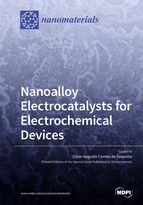Nanoalloy Electrocatalysts for Electrochemical Devices
A special issue of Nanomaterials (ISSN 2079-4991). This special issue belongs to the section "Energy and Catalysis".
Deadline for manuscript submissions: closed (31 October 2021) | Viewed by 15274
Special Issue Editor
Interests: electrochemistry of materials; electrocatalysis; low temperature polymer electrolyte membrane fuel cells; high temperature corrosion
Special Issues, Collections and Topics in MDPI journals
Special Issue Information
Dear Colleagues,
Metallic, bimetallic, trimetallic, and other nanoalloy electrocatalysts have the potential to provide superior and cost-effective solutions to meet the requirements of contemporary and evolving electrochemical devices. The main factors that influence the catalytic activity of nanoalloys are the electronic, geometric and other poststructural effects, point defects, synergistic effects, surface strain, carbon-based stabilizers, etc. The fields of direct borohydride and alcohol fuel cells, batteries, supercapacitors, water electrolyzers, solar cells, sensors, electrochromic displays, electro-degradation devices and hydrogen peroxide producers, among others, offer key application opportunities for novel nanoalloys developed by new synthesis techniques, and presenting unique properties.
This Special Issue will cover the most recent advances in nanoalloy electrocatalysts, concerning, not only the synthesis, characterization, and modeling, but especially reports of their activity, functionality, durability, and low-cost for electrochemical devices.
Prof. Dr. César Augusto Correia de Sequeira
Guest Editor
Manuscript Submission Information
Manuscripts should be submitted online at www.mdpi.com by registering and logging in to this website. Once you are registered, click here to go to the submission form. Manuscripts can be submitted until the deadline. All submissions that pass pre-check are peer-reviewed. Accepted papers will be published continuously in the journal (as soon as accepted) and will be listed together on the special issue website. Research articles, review articles as well as short communications are invited. For planned papers, a title and short abstract (about 100 words) can be sent to the Editorial Office for announcement on this website.
Submitted manuscripts should not have been published previously, nor be under consideration for publication elsewhere (except conference proceedings papers). All manuscripts are thoroughly refereed through a single-blind peer-review process. A guide for authors and other relevant information for submission of manuscripts is available on the Instructions for Authors page. Nanomaterials is an international peer-reviewed open access semimonthly journal published by MDPI.
Please visit the Instructions for Authors page before submitting a manuscript. The Article Processing Charge (APC) for publication in this open access journal is 2900 CHF (Swiss Francs). Submitted papers should be well formatted and use good English. Authors may use MDPI's English editing service prior to publication or during author revisions.
Keywords
- nanoalloys
- electrocatalysts
- synthesis of nanomaterials
- modern electrochemical devices







